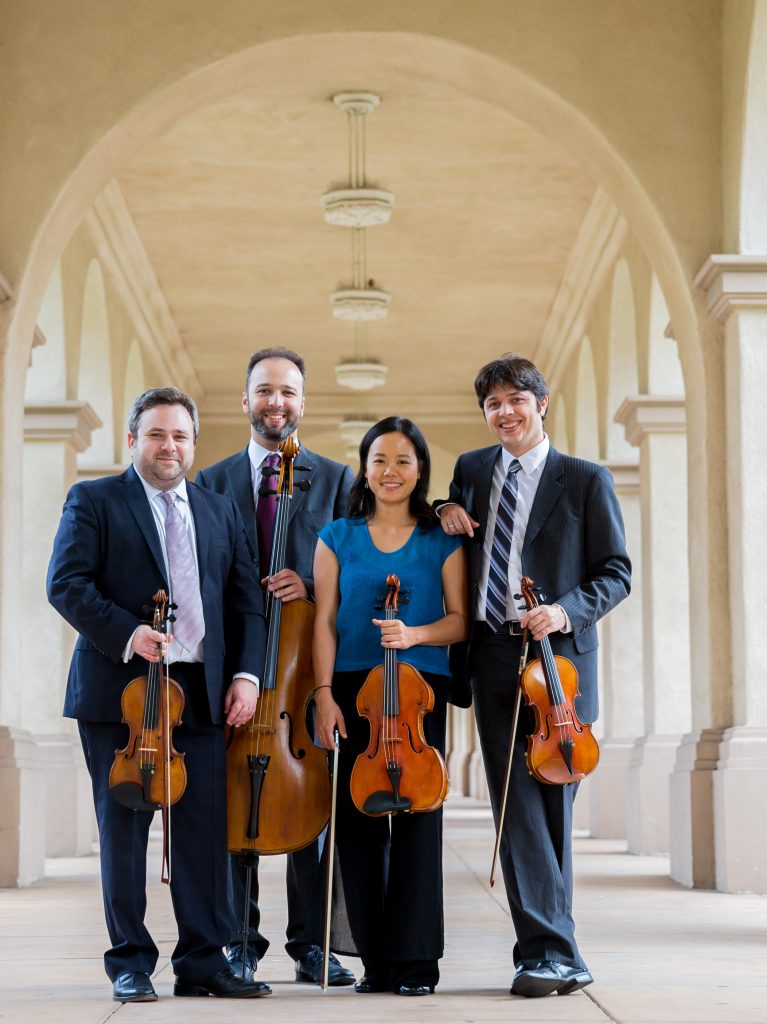Hausmann Quartet Presents Luminous Account of Haydn’s ‘Seven Last Words’ at St. Paul’s Cathedral
In a break from the Hausmann Quartet’s laudable traversal of the string quartets of Joseph Haydn at the Maritime Museum of San Diego, the musicians made a sage detour Friday evening, March 23. Performing Haydn’s most unusual string quartet, “The Seven Last Words of Christ,” Op. 51, in the dim light of St. Paul’s Episcopal Cathedral provided the ideal ambience in which to contemplate the composer’s spiritual meditation.

Hausmann Quartet: Bram Goldstein, Alex Goldbaum, Angela Choong & Isaac Allen [photo courtesy of Hausmann Quartet]
In Christian theology, the “seven last words” of Jesus are actually all seven of Jesus’ final statements made from the cross prior to his death, seven phrases culled from the four Gospels of Christian Scripture, since each Gospel writer gave a slightly different version of the crucifixion. No single Gospel account contains all seven statements. In Christian practice, members of the clergy have used these seven statements as the basis of their preaching during the week before Easter, especially on Good Friday.
What is surprising about Haydn’s seven meditations is that they exude such gracious and uplifting music. They convey no sorrow, no mourning, none of the dark Pietistic soul-searching that characterize the Passions of J.S. Bach. A devout Roman Catholic, Haydn was also a son of the Enlightenment, who understood the Divine as the Omnipotent Benefactor of humanity. So although medieval iconography had stressed the suffering of the crucifixion, the Enlightenment saw that event as the pathway of humanity’s salvation and exultation. The major oratorios Haydn wrote at the very end of his career—The Creation and The Seasons—bear out this theology.
From the bold but deftly measured strokes of Haydn’s Introduction to “The Seven Last Words” as well as the ardently sculpted themes that followed them, Hausmann evoked scenes of serene grace through each of the seven movements. With the exception of the postlude, a fast, forceful depiction of the earthquake that only the Gospel of Matthew includes as a consequence of Jesus’ death, each of the seven movements is written in a slow tempo. Hausmann wisely discovered the many nuances of phrasing and texture that Haydn used to overcome the potential monotony of this inherent restriction, and the warm, resonant acoustic of the cathedral provided a glowing halo around their sumptuously produced sonorities.
In the two movements following the Introduction, first violinist Isaac Allen offered a bountiful array of resplendent solo lines, which the composer bestowed so lavishly on the lead violin. In the third and fifth movements, cellist Alex Greenbaum had the chance to flaunt burnished and poised solo flights, even when he was only outlining the composer’s inventive harmonic progressions. Violinist Bram Goldstein and violist Angela Choong contributed to the quartet’s rich and expertly balanced sonority, even if the composer did not see fit to grace them with the many solo opportunities he found for the outer voices.
Between each movement of “The Seven Last Words,” Cathedral Dean Penny Bridges read short excerpts of English poetry from John Donne to Edith Sitwell that related to the events and meaning of Holy Week. Unfortunately, what the cathedral’s acoustics did to bless the music making also worked against the comprehension of such distilled and weighty poetic thoughts. But the Dean’s heart was surely in the right place.
The Hausmann Quartet was presented by the Cathedral Church of St. Paul in the Bankers Hill section of San Diego on Friday, March 23, 2018. This ensemble continues its Haydn Voyages series at the Maritime Museum of San Diego on May 6, 2018.

Ken Herman, a classically trained pianist and organist, has covered music for the San Diego Union, the Los Angeles Times’ San Diego Edition, and for sandiego.com. He has won numerous awards, including first place for Live Performance and Opera Reviews in the 2017, the 2018, and the 2019 Excellence in Journalism Awards competition held by the San Diego Press Club. A Chicago native, he came to San Diego to pursue a graduate degree and stayed.Read more…
